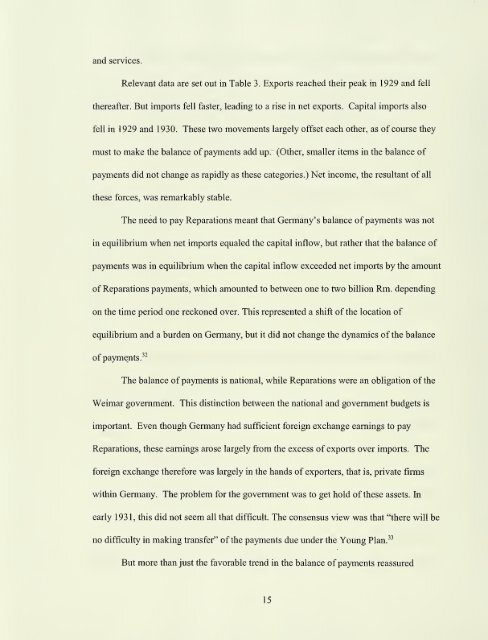Made in Germany : the German currency crisis of July 1931
Made in Germany : the German currency crisis of July 1931
Made in Germany : the German currency crisis of July 1931
Create successful ePaper yourself
Turn your PDF publications into a flip-book with our unique Google optimized e-Paper software.
and services.<br />
Relevant data are set out <strong>in</strong> Table 3. Exports reached <strong>the</strong>ir peak <strong>in</strong> 1929 and fell<br />
<strong>the</strong>reafter. But imports fell faster, lead<strong>in</strong>g to a rise <strong>in</strong> net exports. Capital imports also<br />
fell <strong>in</strong> 1929 and 1930. These two movements largely <strong>of</strong>fset each o<strong>the</strong>r, as <strong>of</strong> course <strong>the</strong>y<br />
must to make <strong>the</strong> balance <strong>of</strong> payments add up. (O<strong>the</strong>r, smaller items <strong>in</strong> <strong>the</strong> balance <strong>of</strong><br />
payments did not change as rapidly as <strong>the</strong>se categories.) Net <strong>in</strong>come, <strong>the</strong> resultant <strong>of</strong> all<br />
<strong>the</strong>se forces, was remarkably stable.<br />
The need to pay Reparations meant that <strong><strong>German</strong>y</strong>'s balance <strong>of</strong> payments was not<br />
<strong>in</strong> equilibrium when net imports equaled <strong>the</strong> capital <strong>in</strong>flow, but ra<strong>the</strong>r that <strong>the</strong> balance <strong>of</strong><br />
payments was <strong>in</strong> equilibrium when <strong>the</strong> capital <strong>in</strong>flow exceeded net imports by <strong>the</strong> amount<br />
<strong>of</strong> Reparations payments, which amounted to between one to two billion Rm. depend<strong>in</strong>g<br />
on <strong>the</strong> time period one reckoned over. This represented a shift <strong>of</strong> <strong>the</strong> location <strong>of</strong><br />
equilibrium and a burden on <strong><strong>German</strong>y</strong>, but it did not change <strong>the</strong> dynamics <strong>of</strong> <strong>the</strong> balance<br />
<strong>of</strong> payments. 32<br />
The balance <strong>of</strong> payments is national, while Reparations were an obligation <strong>of</strong> <strong>the</strong><br />
Weimar government. This dist<strong>in</strong>ction between <strong>the</strong> national and government budgets is<br />
important. Even though <strong><strong>German</strong>y</strong> had sufficient foreign exchange earn<strong>in</strong>gs to pay<br />
Reparations, <strong>the</strong>se earn<strong>in</strong>gs arose largely from <strong>the</strong> excess <strong>of</strong> exports over imports. The<br />
foreign exchange <strong>the</strong>refore was largely <strong>in</strong> <strong>the</strong> hands <strong>of</strong> exporters, that is, private firms<br />
with<strong>in</strong> <strong><strong>German</strong>y</strong>. The problem for <strong>the</strong> government was to get hold <strong>of</strong> <strong>the</strong>se assets. In<br />
early <strong>1931</strong>, this did not seem all that difficult. The consensus view was that "<strong>the</strong>re will be<br />
no difficulty <strong>in</strong> mak<strong>in</strong>g transfer" <strong>of</strong> <strong>the</strong> payments due under <strong>the</strong> Young Plan. 33<br />
But more than just <strong>the</strong> favorable trend <strong>in</strong> <strong>the</strong> balance <strong>of</strong> payments reassured<br />
15



